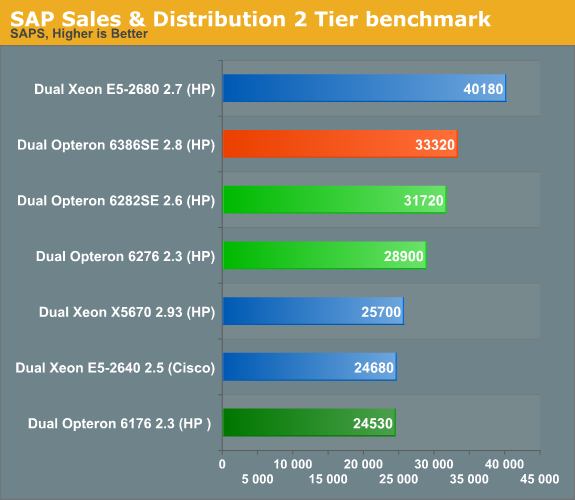The new Opteron 6300: Finally Tested!
by Johan De Gelas on February 20, 2013 12:03 AM ESTSAP S&D
The SAP S&D 2-Tier benchmark has always been one of my favorites. This is probably the most real world benchmark of all server benchmarks done by the vendors. It is a full blown application living on top of a heavy relational database. And don't forget that SAP is one of the most successful software companies out there, the undisputed market leader of Enterprise Resource Planning.
SAP is thus an application that misses the L2 cache much more than most applications out there, with the exception of some exotic HPC apps. We made an in depth profile of SAP S&D, but here is the summary:
- The application has very low instruction level parallelism (ILP) and as a result is not taxing the integer units much (IPC = 0.3-0.55, SPECint 2006: >1) .
- SAP misses the L2 cache much more than most applications out there (4 to 10 times more than SPECint2006 apps)
- The application has a relatively large but "prefetcheable" instruction footprint, which allows the prefetchers to reduce the instruction related cache misses
- The application has a massive and random data footprint, putting great pressure on the load subsystem. As a result the out of order engine has to hide the latency the best it can, and large ROB and load buffers help a lot. The latency of the memory subsystem matters.

The new Opteron does not boost SAP performance. A 6% clock increase translates into a 5% performance increase. As we discussed previously, SAP is one of the few complex server applications where the "Interlagos" Opteron performs a lot better than its predecessor. The application does not seem to benefit from any of the small improvements that the Piledrive core offers. Or maybe HP's benchmark team did not spend much time on this particular benchmark. Since the HP score is the only Interlagos score available, we have no other option than to wonder which of the two options is the closest to the truth.
Not that it matters much: the best SAP servers are Xeon E5 based. In this market of expensive consulting and software, $500 dollar savings on hardware is peanuts. So people tend to go for the best performance, and the Xeon E5 are clearly better at delivering raw SAP performance.










55 Comments
View All Comments
JohanAnandtech - Wednesday, February 20, 2013 - link
Per Core. So with the -np 32 setting. I have tried less before, but the LS-DYNA really likes the extra load and store units of the second unit. so 32 MPI processes give a 30% boost.alpha754293 - Wednesday, February 20, 2013 - link
That's a healthy boost! It's amazing how these technologies are maturing to the point where conventional wisdom that they might be starved for FPU resources isn't enough to slow them down.It'd be interesting to see whether it makes a difference if you were to let the OS handle the job/process scheduling or whether manual intervention can help reduce some of the thread/process migration overhead, especially across 16 FPUs.
dmytty - Friday, February 22, 2013 - link
Before the benchmarks came in, I looked at an HPC build for the new 6300 series. I saw the real sweet spot for AMD being the 6344 which is a CPU of type 2.6 Ghz @ 12 or 6 core (depending how you define a 'core'). Anandtech never mentioned this CPU in the review. (?)In simple $ terms for the CPU, it's the E5 2640 @ $815 vs the Opteron 6344 @ $415. So how does AMD not have a decisive price advantage?
In 4S land the price advantage widens.
AMD 4S...I priced a build (not including a case) at ~$3860 for 4 x 6344, 128 GB RAM, mobo and PSU. Note that this mobo could also go out to 256 GB. CPU cost is 4 x 6344 = $1660. Again, total system cost was $3860.
Intel 4S...I picked the 4607 as being the best 'bang for the buck processor'. It's 6 cores @ 2.2 Ghz. However, at $885 per 4607 processor the CPU cost is more than double than AMD (ie 4x Intel 4607 = $3540). The same build cost using the Intel 4607 would then be $5740.
AMD @ $3860 vs Intel @ $5740. Why did Anandtech not talk about 4S? Why no mention of the 6344?
dmytty - Friday, February 22, 2013 - link
I forgot to mention that the Intel board I specified for 4S build was $1200 whereas the AMD board was $800.A marketing person would call the system cost comparison ~$3k vs $~6k.
Again, am I missing something?
The AMD 6344 based 4S system has a ~19% clockspeed advantage and comes in at 62% of the cost.
Worried about electrical cost? You can buy 700 watts of PV solar panels with the cost savings between AMD and Intel. 700 watts peak = ~3.5 kwh daily output. That would nicely mitigate (and then some) the 20 watts/cpu difference (80 watts total with 4x cpu) between AMD 6344 and Intel 4607. You would net about 1.5 kwh/day electricity going with the AMD + PV over the slightly more efficient Intel.
geok1ng - Monday, May 19, 2014 - link
this is all and good, but looking at spec int 2006 results, Abu Dhabi still does not match performance/watt of Magni Cours opterons. And the best competition AMd can offer against 2 gen old Xeons is still the Opteron 6180.